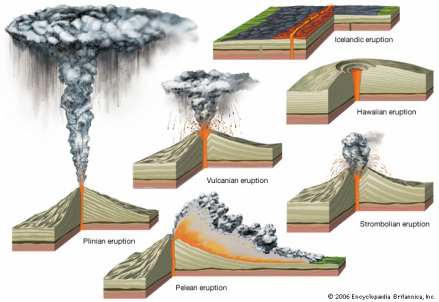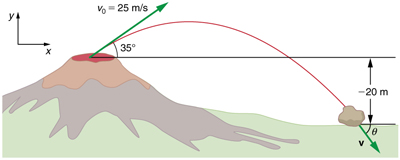Volcanic Physics
Volcanic Physics
Why is Kilauea Different?
Kilauea is not like the other volcanoes because it is not on a tectonic plate line. It is completely in the middle of a tectonic plate.
What causes volcanos to erupt?
A volcano will have an explosive eruption in one of three ways. Possibly fragmentation of the magma, fragmented mass blasting through the vent to the surface and the climb of the eruption column. When the pressure and force acting upon the rock becomes greater than the force of the rock the explosive eruption occurs. Also, thermal energy within the magma causes these eruptions. Thermal energy is transferred into kinetic energy within the eruption column through gases expanding from molecules and joing together into bubbles. The viscosity of magma, dissolved eruption volatiles and mass eruption rate are all variables that can affect the eruption.
 Types of Eruptions
Types of Eruptions

Volcanos on Other Planets, the role of gravity
The different masses of other planets affects their gravity fields. Earth's gravitational pull is stronger in areas with more mass and weakerer in areas with less mass. So when there is suddenly more magma in an area, more mass, can indicate likely volcanic activity.
When there is less gravity on a volcano, the magma can be rising from the core of a planet and be much more buoyant and the convection current will be delayed. Scientists, Wilson and Head, show that this means that dikes (cracks through which lava travels) will be much larger, and that the amount of lava erupted (the effusion rate) could be possibly 5 times greater than on Earth. Also, on Mars the magma chambers are predicted to be deeper than those on earth creating more differences. The effect of lava flows themselves are a somewhat counter-intuitive on other planets. According to Wilson and Head, lava flows on Mars should be longer than the ones on Earth, because of the smaller gravity. I thought this meant the lava would not travel as far because of the lessened force pulling it downhill. But lava stops when it cools down and stops acting like a liquid and slowly becomes a solid. On Mars, where gravity isn’t as strong, lava flows can be thicker, and that means that they don’t cool as quickly. Along with wider dikes and more lava, Wilson and Head predict that the lava flows on Mars can be 6 times longer than those on Earth.
When there is less gravity on a volcano, the magma can be rising from the core of a planet and be much more buoyant and the convection current will be delayed. Scientists, Wilson and Head, show that this means that dikes (cracks through which lava travels) will be much larger, and that the amount of lava erupted (the effusion rate) could be possibly 5 times greater than on Earth. Also, on Mars the magma chambers are predicted to be deeper than those on earth creating more differences. The effect of lava flows themselves are a somewhat counter-intuitive on other planets. According to Wilson and Head, lava flows on Mars should be longer than the ones on Earth, because of the smaller gravity. I thought this meant the lava would not travel as far because of the lessened force pulling it downhill. But lava stops when it cools down and stops acting like a liquid and slowly becomes a solid. On Mars, where gravity isn’t as strong, lava flows can be thicker, and that means that they don’t cool as quickly. Along with wider dikes and more lava, Wilson and Head predict that the lava flows on Mars can be 6 times longer than those on Earth.
Velocities of Volcanic Eruptions
The rest of the blog is in a different font because I had to insert equations from a different website because I haven't foound a way to insert them here without copying it from microsoft word and the font won't switch over. I typed all of the info in word too.
Kilauea in Hawaii is the world’s most continuously active volcano. While a volcano is active it will spurt lava and rocks so hot they turn red. The red-hot rocks and lava can be ejected from the volcano at speeds of 25.0 m/s and at all angles. an angle 35.0º above the horizontal. The rock strikes the side of the volcano at an altitude 20.0 m lower than its starting point. Calculating the time it takes the rock to follow possible paths can help predict possible damage to the surrounding area of Kilauea. The magnitude and direction of the rock’s velocity at impact can also be found just for physics fun.
 The possible trajectory of a rock ejected from Kilauea.
We need to set up the equations in x and y components and then solve for time because this is a projecile motion problem. While the rock is being shot out of the volcano and falling down, the horizontal velocity stays constant.
The possible trajectory of a rock ejected from Kilauea.
We need to set up the equations in x and y components and then solve for time because this is a projecile motion problem. While the rock is being shot out of the volcano and falling down, the horizontal velocity stays constant.
While the rock is in the air, the position changes before and after the projectile motion. Yf is 20.0 m lower than its Yi. We can solve for the time here by using
.
If we take the initial position to be zero, then the final position is . Now the initial vertical velocity is the vertical component of the initial velocity, found from
Substituting in:
.
then
This expression is a quadratic equation of the form , where the constants are , and Its solutions are given by the quadratic formula:
.
This equation gives two solutions:t=3.96s and t= -1.03 s however the time of the projectile is positive so it would take only 3.96 seconds for the projectile to reach the ground.
The time for projectile motion is completely determined by the vertical motion. So any projectile that has an initial vertical velocity of 14.3 m/s and lands 20.0 m below its starting altitude will spend 3.96 s in the air.
Now we can find the horizontal and vertical velocities Vxand Vy and combine them to find the total velocity v and the angle it makes with the horizontal. Of course, Vx is constant so we can solve for it at any horizontal location. In this case, we chose the starting point since we know both the initial velocity and initial angle. Therefore:
The final vertical velocity :
,
where Vy was found in partto be 14.3 m/s.
so that
To find the magnitude of the final velocity v we combine its components, We pythagorize the components which gives this equation:
The direction θv is found from the equation:
The negative angle means that the velocity is 50.1º below the horizontal. This result is consistent with the fact that the final vertical velocity is downward because the final altitude is 20.0 m lower than the initial altitude.
Kilauea in Hawaii is the world’s most continuously active volcano. While a volcano is active it will spurt lava and rocks so hot they turn red. The red-hot rocks and lava can be ejected from the volcano at speeds of 25.0 m/s and at all angles. an angle 35.0º above the horizontal. The rock strikes the side of the volcano at an altitude 20.0 m lower than its starting point. Calculating the time it takes the rock to follow possible paths can help predict possible damage to the surrounding area of Kilauea. The magnitude and direction of the rock’s velocity at impact can also be found just for physics fun.

The possible trajectory of a rock ejected from Kilauea.
We need to set up the equations in x and y components and then solve for time because this is a projecile motion problem. While the rock is being shot out of the volcano and falling down, the horizontal velocity stays constant.
While the rock is in the air, the position changes before and after the projectile motion. Yf is 20.0 m lower than its Yi. We can solve for the time here by using
.
If we take the initial position to be zero, then the final position is . Now the initial vertical velocity is the vertical component of the initial velocity, found from
Substituting in:
.
then
This expression is a quadratic equation of the form , where the constants are , and Its solutions are given by the quadratic formula:
.
This equation gives two solutions:t=3.96s and t= -1.03 s however the time of the projectile is positive so it would take only 3.96 seconds for the projectile to reach the ground.
The time for projectile motion is completely determined by the vertical motion. So any projectile that has an initial vertical velocity of 14.3 m/s and lands 20.0 m below its starting altitude will spend 3.96 s in the air.
Now we can find the horizontal and vertical velocities Vxand Vy and combine them to find the total velocity v and the angle it makes with the horizontal. Of course, Vx is constant so we can solve for it at any horizontal location. In this case, we chose the starting point since we know both the initial velocity and initial angle. Therefore:
The final vertical velocity :
,
where Vy was found in partto be 14.3 m/s.
so that
To find the magnitude of the final velocity v we combine its components, We pythagorize the components which gives this equation:
The direction θv is found from the equation:
The negative angle means that the velocity is 50.1º below the horizontal. This result is consistent with the fact that the final vertical velocity is downward because the final altitude is 20.0 m lower than the initial altitude.

Comments
Post a Comment